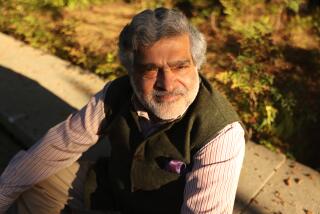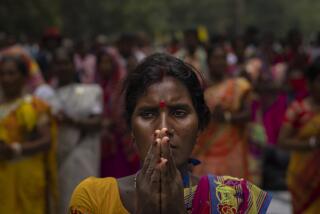Elderly Handful Lives Simply in India Ashram : Untouchables Still Remember ‘Gandhiji’
- Share via
ASHRAM SABARMATI, India — Tucked away down a dusty lane, a handful of old men live the simple life of abstinence and denial they learned as youths from their mentor, Mohandas K. Gandhi.
They are “untouchables,” or Hindus below the lowest level of the caste system. Gandhi called them harijans, “Children of God.” The removal of the scourge of untouchability was among the principal goals of the great Indian advocate of nonviolence.
As young men, the untouchables came to this ashram, or settlement, which Gandhi established in 1915 on a parched plateau above the Sabarmati River outside the western city of Ahmedabad, about 500 miles from New Delhi.
Low-Cost Housing
When Gandhi closed Ashram Sabarmati in 1933, he stipulated that the harijans could stay, paying rent of two rupees (now 16 cents) a year to an untouchables society he helped establish.
Death has reduced the number of harijans who actually lived with Gandhi--the Mahatma to his followers--to fewer than 10 old men. Children and grandchildren of the original Ashram harijans-- 4,000 to 5,000 of them--live with the elders in 200 houses, situated across the highway from the main part of the settlement, which the government maintains as a museum.
“There are very few of us who remember ‘Gandhiji,’ ” said Arjun Bhai, 80, using a Hindi-language term of endearment for the independence leader. “We are too old to work now, but our sons have all taken up different professions.”
Bhai and his friends spend their time now resting in the shade and occasionally spinning cloth on simple spools, a technique Gandhi promoted as a means of asserting Indian economic independence and self-sufficiency.
Ratnaji Nagji Bhai recalls that, for Gandhi, spinning was not simply a task but a duty.
“I came to the ashram in 1922 because I wanted to get married to a girl here,” he said. “I didn’t know how to spin. Gandhiji wouldn’t let me get married until I knew how to spin. It took two years to learn, but then he married us.”
Life for the untouchables here is simple, but the standard of living is still above that of millions of impoverished Indians--especially the untouchables, who often face a life of filth, poverty, disease and the most unpleasant forms of work.
Here, they live in large, single-story homes of stone and wood. Sloping roofs protect stone-floor porches from the ravages of the Indian summer heat.
A grove of trees shields them from the sights and sounds of the nearby highway, removing the settlement from the symbols of technology that Gandhi dismissed as a form of oppression.
A few of the harijans receive government pensions of $25 a month for having participated in Gandhi’s civil disobedience campaigns against British rule.
Old Order Changing
When the last of the old ashram members dies, a way of life will pass with them. The modern India of sprawling cities, factories and the trappings of Western civilization is far from the pristine values Gandhi taught.
The old men said their sons and grandsons are more interested in getting jobs and making money than in prayer and study, fasting and spinning.
“Even now, it is simple for us because we have nothing,” said Ramji Bhai, 75. “They’ve got money, they’ve got textile mills. So why should they think of simple living? They’re just good at talking now, but not following.”
More to Read
Sign up for Essential California
The most important California stories and recommendations in your inbox every morning.
You may occasionally receive promotional content from the Los Angeles Times.










